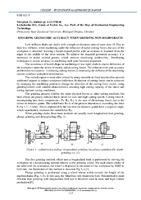Показати скорочений опис матеріалу
Ensuring geometric accuracy when grinding non-rigid shafts
| dc.contributor.author | Stovpnyk, O. | |
| dc.contributor.author | Leshchenko, О. І. | |
| dc.date.accessioned | 2024-01-04T10:21:10Z | |
| dc.date.available | 2024-01-04T10:21:10Z | |
| dc.date.issued | 2023 | |
| dc.identifier.citation | Stovpnyk O. Ensuring geometric accuracy when grinding non-rigid shafts / Stovpnyk O., Leshchenko O.I. // Молодь: наука та інновації : матеріали ХІ Міжнародної науково-технічної конференції студентів, аспірантів та молодих вчених, Дніпро, 22–24 листопада 2023 року. – Дніпро : НТУ ДП, 2023. – Т. 1. – С. 112-113. | uk_UA |
| dc.identifier.uri | http://ir.nmu.org.ua/handle/123456789/165653 | |
| dc.description.abstract | Low stiffness shafts are shafts with a length-to-diameter ratio of more than 10. Due to their low stiffness, when machining under the influence of radial cutting forces, the axis of the workpiece is distorted, forming a barrel-shaped profile with an increase in diameter from the edges to the middle of the cross-section. To achieve the required geometric accuracy it is necessary to make several passes, which reduces machining productivity. Developing techniques to ensure accuracy in machining such parts becomes important. The occurrence of barrel-shape in machining of low rigid shafts is due to deflection of the workpiece under the action of mainly radial cutting forces. The solution to the part accuracy problem has two aspects: 1) reducing cutting forces; 2) increasing the stiffness of the machining system to reduce workpiece deformation. | uk_UA |
| dc.language.iso | en | uk_UA |
| dc.subject | geometric accuracy | uk_UA |
| dc.subject | reducing cutting forces | uk_UA |
| dc.title | Ensuring geometric accuracy when grinding non-rigid shafts | uk_UA |
| dc.type | Article | uk_UA |
| dc.identifier.udk | 621.9 | uk_UA |

